Prized for its prolific range of varietals, the state’s first American Viticultural Area Washington supplies grapes for one-fourth of all Washington wine production
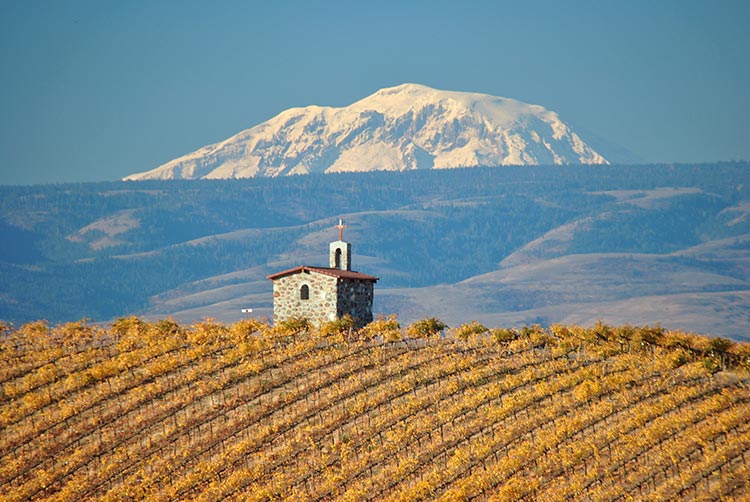
Written by editor John Vitale
IT WAS FORTY YEARS AGO ago when the Federal government officially declared Yakima Valley to be the first American Viticultural Area (AVA) north of Napa Valley. To put it in perspective with the rest of the West Coast growing regions, Napa Valley was California’s first AVA established in 1981, followed on its heels by the formation of the Yakima Valley AVA a scant two years later in 1983.
Yakima Valley AVA cultivates 19,000 acres of vineyards. Scores of wineries across the state seek out and buy grapes specifically grown in the Yakima Valley (including its five distinct sub-AVAs of Red Mountain, Rattlesnake Hills, Snipes Mountain, Candy Mountain and most recently, Goose Gap).
To illustrate the significance of the Yakima Valley as an agricultural belt, its wine grapes account for 25% of Washington’s total annual wine production, while Napa Valley represents just 4% of California’s wine production.
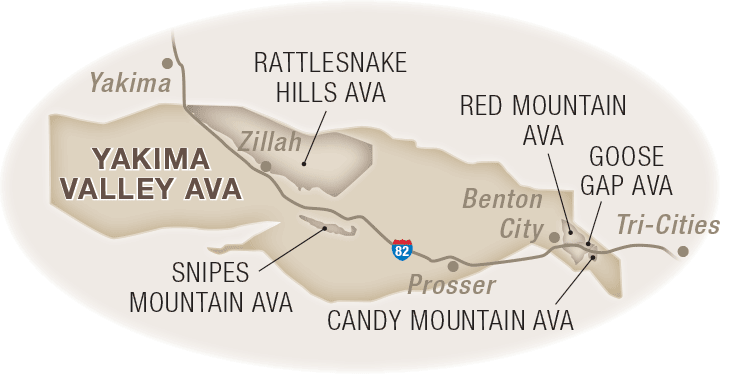
Pioneer Vineyards
Grower Mike Sauer of Red Willow Vineyard began planting wine grapes in 1973 before the Yakima Valley AVA was formed. “I remember the western boundary of the AVA just included our vineyard,” he says.
Another early grower was Dick Boushey, who planted an experimental block of 10 different varieties on their farm in 1977. “I had been an apple, cherry and Concord grower in the valley, but I was always intrigued by old Otis Vineyard and Lester Fleming Vineyards that were planted in the 60’s near my farm,” he says. In 1980 he expanded on this with his first commercial block of Cabernet Sauvignon, Merlot, Cabernet Franc and Chenin Blanc, most of which he still farms.
Scott Williams, a well-known grower and vintner on Red Mountain, and proprietor of Kiona Vineyards, says his first vintage was in 1980. “In the early years we used only estate grown fruit and the wine was all labeled as Yakima Valley since the Red Mountain AVA did not come along until much later,” he says. Scott recollects there were only five other wineries in operation at the time in the proposed AVA, citing Hinzerling, Yakima River Winery, and Tucker Cellars, as well as Covey Run and Hogue.
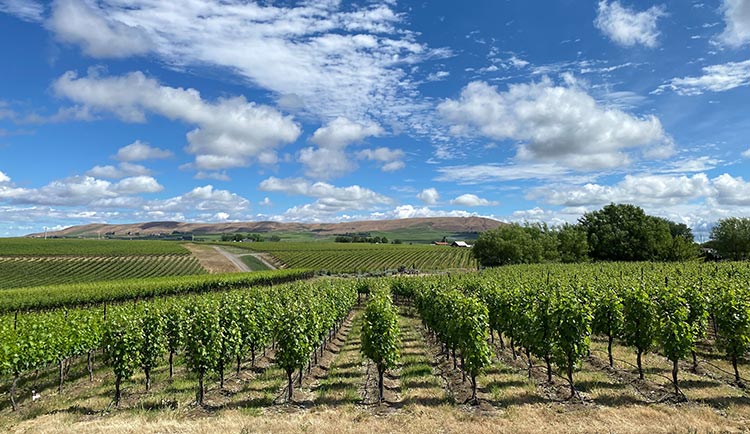
Farm to Table
Today the AVA is home to about 100 wineries and tasting rooms. “The Yakima Valley AVA represents the rich diversity of agricultural crops and cultures found in this totally unique part of the world,” says Mike Sauer.
The agricultural aspect that Sauer mentions is driving culinary tourism throughout the region. “Farm to table is not a catchy phrase here; it’s our way of life,” says John Cooper, president and CEO of Yakima Valley Tourism, who has been with the bureau for 16 years. “The wine industry is a pivotal part of our culture and lifestyle. I think the vineyard/tasting experiences at many of the wineries are a perfect example of farm to glass. Wine country is farm country.” He is referring to the valley’s 3,000 farms that produce everything from asparagus to zucchini, and the fact they are an international leader in many crops including hops, apples, mint and cherries.
Consumers are becoming increasingly interested in the connection between the land and the foods and beverages they eat and drink. John Cooper sees this movement as a bright pathway for the future ahead and believes Yakima Valley wineries will embrace this philosophy. “They will expand efforts to offer more ways to experience the synergy between the land, waterways, vines, winemakers’ passions and the wines they craft. Dineen Vineyards, VanArnam Vineyards, Two Mountain Winery and Whitman Hill Winery are a few examples of wineries and vineyards doing educational tours and providing other ways for folks to do more than just sip at the tasting bar.”
He says public spaces at the wineries are evolving too, with expansive outdoor spaces and indoor areas meant for lingering and learning about the wine experience with family and friends.
As a tribute to Washington State’s oldest AVA turning forty, we asked a number of prominent winemakers and winegrape growers to share what the Yakima Valley AVA means to them personally
Craig Leuthold, Founder and Owner of Maryhill Winery: I believe the most exciting aspect of the Yakima Valley AVA is the quality and diversity of the grapes due to the unique characteristics of the individual vineyards.
The first vineyard that we purchased grapes from in the Yakima Valley AVA was Tudor Hill Vineyards in Grandview in 2002. (Originally those grapes were grown for Washington Hills but they released those grapes after the 2001 vintage.) The owner of our building contractor, Hank Stamschorr, introduced me to Mark Tudor and we have been buying from them ever since. They are now our largest grower with almost 100 acres planted that include Pinot Gris, Chardonnay, Viognier, Sauvignon Blanc, Albariño, Cabernet Sauvignon, Cabernet Franc, Sangiovese, Malbec, Syrah and Merlot. The Tudors also purchased the adjacent Otis Vineyard where we source Cabernet Sauvignon, Syrah, Pinot Gris and Albariño.
Over the years we have purchased from other Yakima Valley AVA vineyards including Chenin Blanc from Zillah Bluff Vineyard, and Grüner Veltliner from Bloxom Vineyard. In addition, one of our favorite vineyards is Elephant Mountain in a sub-AVA that supplies us with many varietals.
Mike Sauer, Grower at Red Willow Vineyard:
I have always been proud to simply use “Yakima Valley” as our identity. The Yakima Valley is connected to so much history of the Washington wine industry, ranging from Charles Schanno and William B. Bridgman’s early vineyards in the valley to the WSU Irrigated Agriculture Research and Extension Center in Prosser and Dr. Walter Clore’s many years of research and study laying the foundation for the modern wine industry of Washington.
Noah Fox Reed, Winemaker at Tinte Cellars:
I have worked with fruit from the Yakima Valley AVA since I started working in the Washington wine industry in 2003. I think it is important to acknowledge that it was one of the first areas in Washington State to have specific areas delineated for sub-AVAs in the Columbia Valley. This has allowed winemakers to be more precise in sourcing fruit from more specific areas where different varietals will show more expression. In particular, Red Mountain AVA is renowned for the quality of grapes, much of which are Bordeaux varietals, and has gained notoriety for the wines produced from those vineyards. We are proud to have two vineyards in the Red Mountain AVA and numerous, long-term relationships with growers throughout the Yakima Valley.
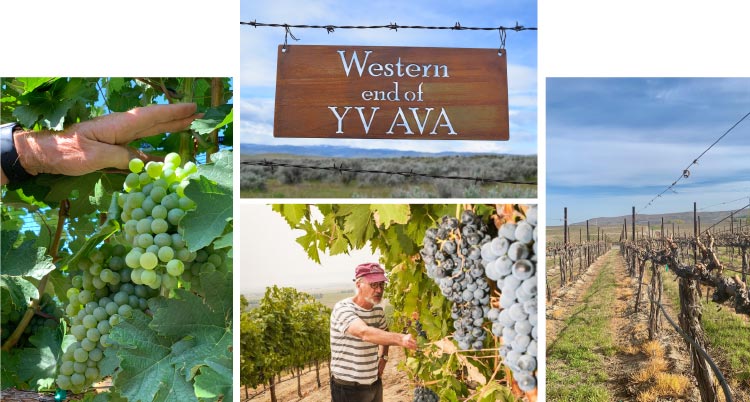
Scott Whitman, Grower and Winemaker at Whitman Hill Winery & Estate Vineyard:
I first started buying Yakima Valley fruit in 2010. When starting out, I wanted to diversify our fruit sources, and purchased grapes from both Yakima Valley and Walla Walla. As the seasons passed, I sourced more and more fruit from the valley, and less from Walla Walla. The Yakima Valley offers such a diverse range of soils and growing areas, you can find high quality fruit to match the wine style you are focused on producing.
In 2011, we started purchasing grapes from Sheridan Vineyard, an exceptionally well-farmed vineyard producing extraordinary fruit. Scott Greer, owner, and winemaker of Sheridan has been the driving force of our focus toward the Yakima Valley, and more specifically the Zillah area located in the Rattlesnake Hills AVA. After some years of influencing, Greer helped us get started planting our own vineyards in the area. Zillah sits up against the northern slopes of the valley where our vineyard is located. The higher elevation and rolling hills with contrasting soils offer varied growing conditions. Some areas of the soils are so rich you can throw a rock in it, and it will probably grow, where other areas are rocky and starve anything that tries to survive there.
This diversity in the vineyard, while challenging to farm, produces truly complex fruits. The geology throughout the vineyard and the whole valley is incredibly interesting. To imagine what it was like thousands of years ago, and what it produces today, we are humbled, and honored to be a part of it and strive to bring that out in our wines.
Brian Carter, Winemaker at Brian Carter Cellars:
I have been making wine in Washington since 1980 and started working with several Yakima Valley Vineyards after starting my consulting career in 1988. These included Covey Run Vineyards in Zillah, Outlook and Upland Vineyards in Sunnyside, Willard Family in Prosser, and Klipsun on Red Mountain.
Today at Brian Carter Cellars, I source about 75% of my fruit from the Yakima Valley including various sub-AVAs. The valley offers up a very diverse selection of terroirs and I am able to find just about (but not quite) everything I need there to satisfy the 20 or so varieties that I bring in every year. These range from the great Roussanne I purchase from Olsen Vineyards which goes into my Oriana to the magnificent Cabernet Sauvignon from both Klipsun and E&E Shaw Vineyards (now owned by Tinte) on Red Mountain that goes into my Solesce and some other Bordeaux-style blends.
Other Yakima vineyards I use currently and have great success from are Lonesome Springs, Dineen, and Upland Vineyards. I have been working with the Newhouse Family at Upland for many decades, more than one generation, and helped plant one of their blocks focused on Iberian varieties.
It is worth noting that for a west-sider, I spend a lot of time in the vineyard talking to growers and working with them to make the most of every harvest. Some growers will joke, “Well, here comes Brian again,” but most enjoy the input. I always have my individual rows marked for me and that way I get the grower to focus on just what I want including green thinning, crop levels, leaf removal and watering.
Alphonse de Klerk, Winemaker at Rolling Bay Winery:
I was first introduced to the Yakima AVA while wine tasting there in the mid to late 80s. All of the wineries were small friendly family run operations with an unpretentious vibe. Today that still remains the same. In 1992 when I was still a home winemaker I was fortunate enough to get introduced to Alfred Newhouse of Upland Vineyards. The cooler sites in the Yakima Valley suits our winemaking style perfectly and we have since spread out to three additional vineyards.
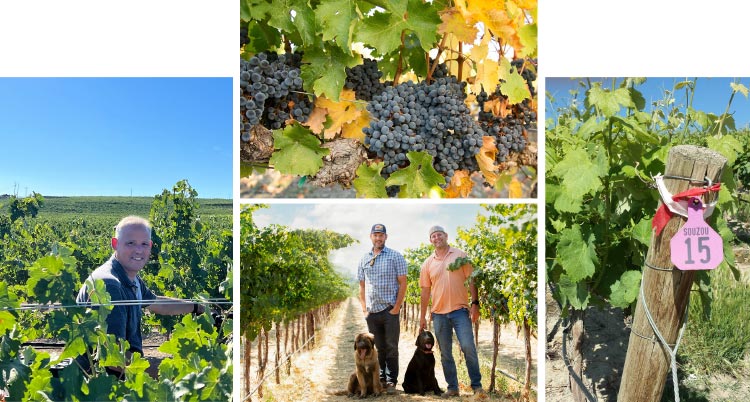
Scott Williams, Grower and Winemaker at Kiona Vineyard & Winery:
For me, the Yakima Valley evokes a sense of community. While the Washington Wine industry remains incredibly open regarding flow of information and the willingness of growers and wineries to work together, it has grown so large that it is impossible to know everyone. That was not the case in the early years. Everyone knew each other, and while the individuals and entities were diverse and generally iconoclastic, the glue that bound everyone together was the desire to lure people to our tasting rooms and hopefully sell them some wine. Enter the Yakima Valley AVA, the first AVA in Washington.
Jim Holmes, Grower at Ciel du Cheval Vineyard:
When I was at Kiona Vineyard we worked with Yakima Valley grapes starting in 1980, somewhat before the AVA was formed. I was part of the small group of wineries that formed the AVA. It was lead by Mike Wallace [Hinzerling Winery] and debated boundaries, etc., and we even discussed whether we should create an AVA or just go with Columbia Valley. Personally, I have fond memories of that process.
Robert Smasne, Winemaker at Smasne Cellars:
My first professional vintage with Yakima Valley fruit was in 1998. There is no greater reward than handcrafting wines from an area your family has settled, farmed and loved for over 100 years. When my great grandfather settled in and started farming the Yakima River Valley there was little here but sand and sagebrush. Through the efforts of many, the Yakima Valley became one of the most fertile and agriculturally diverse regions in the world, including the birthplace of Washington wine. It is here as a boy my interest for vineyards and this region began.
Today, five generations later the Yakima Valley AVA has a special place in my heart and continues to be an important part of the Smasne Cellars wine portfolio. As I start my 26th vintage of winemaking within the Yakima Valley, I am thankful for those early pioneers who set the foundation for what is now the Washington wine industry.
Dick Boushey, Grower at Boushey Vineyards:
Wine grape growing was a natural fit in the Valley. There were many talented multi-generational families that had already developed a thriving cherry, apple, hop, juice grape, pear, stone fruit, mint and dairy business in the Valley. This inherent talent and expertise started focusing on the modern day wine grape business. The families that come to mind are Hogue, Wycoff, Olsen, Tudor, Newhouse, Sauer, Willard, Miller, Shiels, Portteus, Harlan, Hedges, DenHoed, Roy, Crawford, Wallace, Brown, Williams, Holmes, Gelles and many more. These families took the next progressive steps and built upon the early pioneers in the valley.
They had the advantage of the WSU Prosser Research and Extension Center being located in the middle of the Valley, where Dr. Walter Clore and his colleges led the efforts to provide the knowledge to grow great grapes not only in the Yakima Valley but the whole state.
This perfect blend of talent combined with the wide diversity of great sites within the Valley has made it one of the most significant wine grape growing areas in the state.
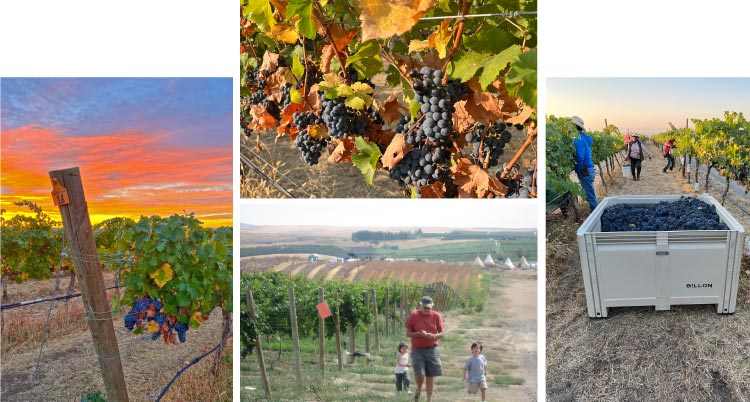
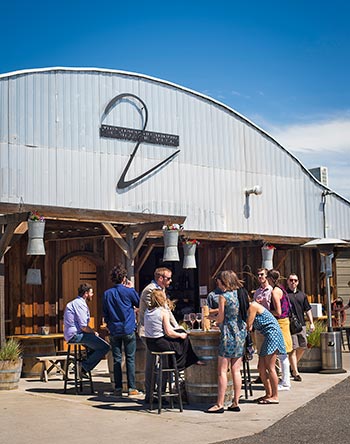
Patrick Rawn, Winemaker at Two Mountain Vineyards:
For all intents and purposes we have only ever worked with Yakima Valley fruit—more specifically, in the Rattlesnake Hills [sub-AVA]. We are 100% estate grown, and very purposefully all of our vineyards are in this area. This started with our first vintage in 2002 and when I came back to the valley full time in 2004.
This place, our little spot in the Yakima Valley, means everything to not only our winery and vineyards but our family. We have farmed here for four generations. As the current generation we view our role as steward more than operator. Making wines that speak to this very specific place is the goal.
Andy Shepherd, Partner at Eight Bells Winery:
In the Yakima Valley there is something special, something different. To us the people are the Yakima Valley’s power and grace that is reflected in the wine. As of 2023, we will produce all our wine from 100% Yakima Valley fruit harvested from two vineyards, Red Willow Vineyard and Boushey Vineyards.
We have worked with the Sauer family for 15 years. In our first meeting with Mike Sauer of Red Willow fame, we talked about our plans, what fruit we wanted, pricing, crop levels, and so forth. It was a very good meeting for both sides. At the end of the meeting, we casually asked if we could buy some Riesling from him. We knew he had some available and we wanted it. He replied that “we couldn’t afford it” and proceeded to tell us why. “Ste. Michelle makes a very good Riesling at such a low price there was no way you could make any money with Riesling.” Wise advice. The entire Sauer family continues to be an integral part of our winery today.
Marissa Dineen, Grower and Winemaker at Dineen Vineyards:
Dineen Vineyards was established in 2001 on what was once a 12-acre apple orchard in the Rattlesnake Hills sub-AVA of the Yakima Valley AVA, just north of the town of Zillah. The trees were removed and the first Dineen vines, Cabernet Sauvignon, Cabernet Franc and Syrah, were planted in what is now known as Catherine’s Vineyard.
I am the second generation owner of Dineen Vineyards and to me, the Yakima Valley represents a place very well suited to growing wine grapes, a pioneering spirit and sense of collaboration and connection.
A passion for food, wine, friends and global travel led founders Pat and Lanie Dineen to vineyards and tasting rooms, foreshadowing the start of Dineen Vineyards. They looked at sites in Napa as well as Walla Walla before settling on the Yakima Valley. They chose Yakima due to the soils, which have a perfect pH for growing wine grapes, the climate, water availability, the aspect and the practical fact that grape vines and tree fruit had been successfully cultivated in the area.
The stunning beauty of the vineyard sites, with views over the valley and Mount Adams and Rainier, as well as the proximity to Seattle, where they lived, were also determining factors for what is a “lifestyle business.”
The Yakima Valley has always been a place for experimentation, change and learning. To us, it is a place to feel grounded and to marvel at the changes that occur throughout the seasons. It was this love of place that encouraged us to become among the first Certified Sustainable vineyards in the state as we steward the land for generations to come.
